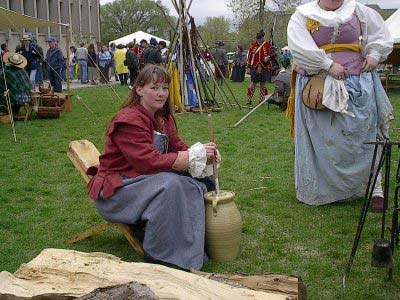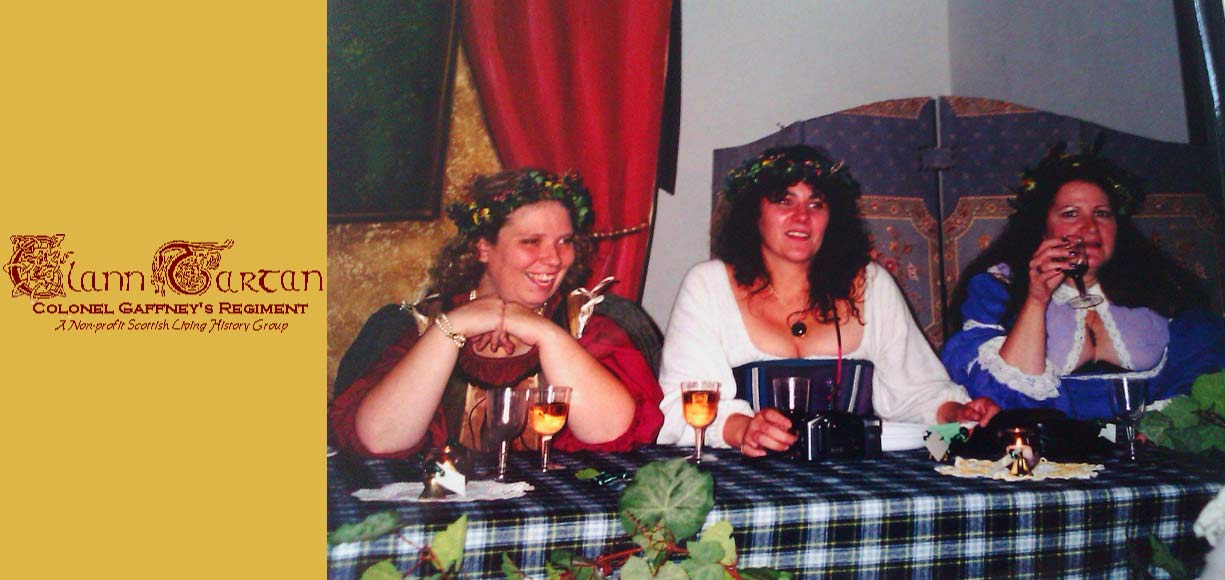The Life of an Herbwife in 1630 Scotland
The early 1600s were characterized by plagues of many kinds, including small pox, influenza, and measles, as well as the "Great Plague", or bubonic. Life expectancy was short - usually under 35 years, especially in crowded conditions such as cities. About one third of newborns, toddlers, and children under 5 died from stomach and bowel disorders, usually caused from poor hygiene. There was also a small ice age, causing crop failures and famine.
In the medical news, blood circulation and the function of the lungs had been discovered and written up, but the people still believed in the powers of mummy dust - pieces of ground up mummy uncovered in Egypt, that was ground up and said to cure anything that ailed you, and unicorn horn - a specific cure for poison. The only country that allowed women to be taught in medical schools was Italy, and the threat of being burned for practicing witchcraft was very real. Herbals became more popular and widespread after the invention of the printing press, and almost every well-to-do housewife in the cities owned one.
In larger towns and cities, the medical hierarchy consisted of physicians, trained at colleges; barber/surgeons, trained either at specialized schools or by apprenticeship; apothecaries, trained by apprenticeship; and "irregulars", which include midwives, herbwives, and nurses. Hospitals were non-existent. The physicians were the elite, able to charge coin for their services, and were always male. The barber/surgeons would either shave you or perform minor surgeries, especially dental work. The origin of the striped barber pole is from this trade - they would hang the bloody sheets out to dry, and a red and white striped sheet evolved into the common barber's pole we still see today. They also were almost always male, especially in the cities. The apothecaries existed primarily in the cities. Most houses had a small plot where kitchen vegetables and select herbs were grown, but the apothecaries had a larger variety and more rare spices. They were also able to compound different medications for a fee, sometimes under the direction of a physician, but frequently on their own. They shared a lot of the same suspicions of witchcraft and causing abortions or providing poison, as the herbwives did. The irregulars filled in the missing spots.
In cities and larger towns, the midwife was separate form the herbwife, and was present at almost all births. The herbwife was primarily active in outlying areas and smaller towns, where she functioned as a midwife, physician, and frequently a surgeon. Nurses were the lowest echelon, usually prostitutes that couldn't make money selling their bodies any longer, they acted under the direction of a physician in the patients home.
Midwives learned their trade largely by experience, not always by apprenticing. Frequently, they learned the hard way - by being in the wrong place at the wrong time and having to deliver a baby using their best judgment. They were licensed by the bishop, and had to prove that they were "of good moral character", regular church goers, and preferably married or respectably widowed. Most of them came from good families, and were literate, but were always under suspicion of causing abortions, supplying what passed for birth control, and killing bastard or deformed babies.
Smaller villages that couldn't support a physician or surgeon made do with "wise-women", or herbwives. The majority of these women, and in rare instances men, were taught by other herbwives in an apprentice system, usually a family relationship. Rarely was an outside apprentice accepted. The remedies that were used and passed on generally were "trade secrets" - specific mixes formulated for the best cure. There was always the danger of being accused of practicing witchcraft, so it was not a generally a favored position, but it was a necessary one.
If an herbwife lived in town, she usually would have an area of her house set aside for "lying in" of pregnant women, or a small hospital for taking care of patients. Most of the herbs she used were either grown or gathered, with a few of the more rare and costly spices either traded or bought. These would be kept under lock and key, and doled out very sparingly. Herbals were becoming popular, but the distribution was limited to the large cities. Every healer kept her own handmade book that included recipes, who was treated and for what, and what, if any, kind of payment was provided.
Payment was usually barter - a chicken for treating the flu, a sheep for a successful birth of a boy, or nothing if the patient died. On rare occasions she would be paid in coin, primarily if she had to use some of her rare spices such as black pepper, nutmeg, or cinnamon. These expensive treatments were saved for those that could pay in coin. In this day and age, a pound of black peppercorn could buy a large house.
Herbwives relied primarily on treating symptoms, and usually preferred to treat "like with like" - for liver complications, an herb shaped or colored like the liver was the first choice. Very little or no attention was paid to the four humours and astrology - that was an idea for the learned, the physicians. The four humors were blood, bile, phlegm, and choler, and they had to be balanced to keep you healthy, the origination of bleeding an ill person to make them healthy. Astrology was used primarily by the top rung of society, and the stars were consulted to find the correct course of treatment.
A typical duty of an herbwife would include assisting in childbirth. There are herbs that are known to ease labor, but in this period they were rarely used because pain in childbirth was "woman's lot" and punishment for the original sin. Women were supposed to suffer. However, women were encouraged to walk around, and sit or squat for birth to make it easier and ergot was a valuable treatment for post delivery bleeding. The link between hand washing and childbed fever was still not known, but the Scots in general tended to wash more frequently, so fewer mothers and babies were lost to puerperal fever than in other countries. Obstetric forceps to assist in removing stubborn babies were invented in 1630, but not widely used for several decades after that since the physician that invented them kept them a family secret. After the secret was "out", it was primarily the physicians and man-midwives that used them – they didn't gain popularity with women midwives.
The next most common treatment would be for injuries including fractures, abrasions, and burns. Simple fractures would be treated by splinting and immobilizing the limb until it was healed. Compound fractures were more difficult to treat. The limb had to be set and traction used, usually involving strong helpers to hold the patient down and provide traction. The break was then splinted and wrapped in wet muslin to support and protect the healing area. Wet muslin was used, as it would shrink as it dried and provided strength to the splint. Infection then was a major concern, and was typically treated with various herbs, including garlic, yarrow, and boneset. Abrasions were cleaned and wrapped in burdock leaves to promote healing. Burns were wrapped in cloth saturated with grease, usually goose.
Severe infections would often necessitate amputation, a risky procedure with no anesthesia other than alcohol, and morphine for the rich. Common tools for this include the saw from the woodpile, and the needle and thread from the sewing kit. This procedure frequently killed the patient, if not from the shock of the surgery, from the resulting infection. Surprisingly, many people did survive and continue to lead productive lives.
Dental care was another area of treatment. The "old wives tales" said that a woman would lose a tooth for each pregnancy, due to the calcium depletion during pregnancy. This was less common in Scotland due to a higher calcium diet, but scurvy was a definite problem. Prevalent in the winter months when fresh produce was difficult to find, scurvy results bleeding gums and the loss of teeth due to a deficiency of vitamin C. The only "treatment" was to provide diet additions such as dried nettles and rose hips over the winter. Dental hygiene, including brushing, was rare. Infections of both teeth and gums were common, and usually treated by tooth extraction. Minor dental problems could be alleviated with application of clove oil, which numbed the area and provided a bit of antibacterial action.
The herbwife was generally well respected, but it was a fine line she walked between being a healer and a witch, especially in Scotland in the 1600s. If she trafficked in charms, whether white or black, she was at risk for being named a witch - a sure death sentence. If she lost too many patients she would lose her profession and probably be accused as a witch. She would need to be under the protection of a man, either her husband or an official. The best protector was someone involved with the Church, a vicar or priest, or as a campfollower, an officer.
In general, it was an interesting life, and generally easier than a farm wife. There was money and respect to be earned, and a certain amount of independence. The life allowed unrestricted travel and visiting, and the chance to be first with all the interesting gossip. It was also one of the few professions where women were in charge and able to tell men what to do, and to gain a certain amount of power.
Bibliography:
*The Age of Agony, Guy Williams, Academy Chicago Publishers, 1996
*Disease, Medicine and Society in England, 1550-1860, Roy Porter, Cambridge University Press, 1993
*Medicine and society in Later Medieval England, Carole Rawcliffe, Sutton Publishing Ltd., 1997
*Medieval and Early Renaissance Medicine, Nancy G. Siraisi, University of Chicago Press, 1990
*Plagues and Peoples, William H. McNeill, Anchor Books Doubleday, 1977
*Plague, Pox, and Pestilance, Kenneth F. Kiple, Barnes and Noble, Inc., 1997
*Witches, Midwives and Nurses, a History of Women Healers, Barbara Ehrenreich and Deirdre English; Feminist Press at the City University of New York, 1973
*Woman as Healer, Jeanne Achterberg, Shambhala Publications, Inc., 1990
*Woman Healers, Elisabeth Brooke, Healing Arts Press, 1995
*Women in Medicine, Kate Campbell Hurd-Mead, Haddam Press, 1938
(This article has been submitted to and approved by a panel of peers. The author has been tested on knowledge, applied for, and received their Level 4 Muster)

